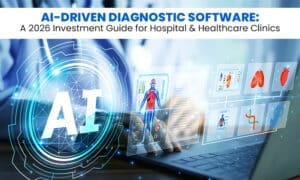
In today’s fast-paced healthcare environment, managing patient flow efficiently has become one of the most significant challenges hospitals faces. Recent studies show that nearly 75% of hospitals report patient flow issues as a major concern, with inefficient processes leading to longer waiting times, reduced patient satisfaction, and increased operational costs. HIMS software solutions (Hospital Information Management Systems) have emerged as powerful tools to address these challenges, offering integrated approaches to streamline patient journeys from admission to discharge.
The global HIMS market is growing rapidly, expected to reach £38.4 billion by 2026, as more healthcare facilities recognise the transformative potential of these digital systems. While traditional hospital operations often relied on paper-based records and manual scheduling, modern healthcare management technology enables real-time tracking, automated resource allocation, and data-driven decision making.
This shift isn’t just about adopting new technology, it’s about fundamentally reimagining how hospitals deliver care to maximise efficiency without compromising quality. This article explores the essential HIMS software solutions that every hospital needs to improve patient flow, examining how these tools can transform bottlenecks into smooth pathways and enhance the experience for both patients and healthcare providers.
Also read- Revealing the Hidden Secrets Behind NPHIES
Patient Registration and Queue Management Systems
The patient journey begins at registration, and this first touchpoint often sets the tone for the entire hospital experience. Traditional paper-based registration processes can create significant bottlenecks, with research indicating that patients spend an average of 22 minutes completing registration formalities—time that could be better used for clinical care. Digital admission systems are transforming this crucial first step in the patient journey.
Modern HIMS solutions offer streamlined registration modules that capture patient information quickly and securely, eliminating redundant data entry and reducing waiting times. These systems typically include digital forms that patients can complete before arrival using patient portals, kiosk-based self-registration options within the facility, and queue management features that provide realistic waiting time estimates. Some advanced systems even incorporate biometric patient identification to further speed up the process for returning patients while enhancing security.
- Streamlined Registration: Modern HIMS offer quick, secure patient data capture, reducing redundancy and wait times.
- Multiple Entry Options: Includes digital pre-arrival forms (patient portals), self-registration kiosks, and queue management with wait time estimates.
- Enhanced Speed & Security: Advanced systems use biometric identification for returning patients.
The benefits extend beyond just saving time. Digital registration systems reduce transcription errors that might affect clinical decisions later in the care process. They also enable better resource planning by providing real-time visibility of incoming patient volume. Many hospitals implementing these solutions report 30-40% reductions in registration waiting times and significant improvements in patient satisfaction scores related to administrative processes. Queue management components help distribute patient flow more evenly throughout the day, reducing peak-time congestion and allowing staff to provide more attentive service. For hospitals just beginning their digital transformation journey, patient registration systems often represent a high-value first step toward comprehensive hospital management software implementation.
Real-Time Bed Management Solutions
Bed management remains one of the most critical aspects of hospital operations, directly impacting patient flow, care quality, and financial performance. In traditional settings, bed allocation often relies on phone calls, whiteboards, and manual coordination between departments—a process that’s both time-consuming and prone to errors. Studies show that inefficient bed management can extend patient waiting times by up to 2.5 hours and increase length of stay by nearly 11%.
Electronic Bed Tracking Systems:
- Real-time Bed Visibility: Systems display live bed status (occupied, vacant, cleaning, reserved) across the facility.
- Efficient Patient Matching: Staff can quickly find suitable beds for waiting patients based on their needs.
- Automated Bed Turnover: Integration with housekeeping streamlines bed cleaning and availability updates for admissions.
- Significant Impact: Hospitals report reduced turnaround times (20-30%) and decreased ED boarding hours.
- Improved Safety & Resource Use: Ensures appropriate bed assignments, aids infection control, and provides data for staffing and capacity optimisation.
Also Read- Choose Wisely for Your Hospital Administration Software
Clinical Workflow Optimisation Tools
Once patients are admitted, their journey through the hospital involves numerous clinical processes—consultations, diagnostics, treatments, and monitoring. Without proper coordination, these processes can create delays that extend the length of stay and reduce patient satisfaction. Research indicates that up to 30% of hospital time is spent on administrative tasks rather than direct patient care, highlighting the urgent need for workflow optimisation.
Clinical workflow management tools within comprehensive HIMS solutions help coordinate care delivery across departments by tracking each step in treatment protocols and alerting relevant staff about pending tasks. These systems typically include digital task lists for healthcare providers, automated clinical pathways that suggest next steps based on diagnoses, and communication tools that notify the right personnel at the right time. Advanced solutions incorporate artificial intelligence to predict potential bottlenecks before they occur and suggest workflow adjustments.
Using the Patient Portal and Mobile App for Faster Patient Flow at the Lobby
Implementing a patient portal and mobile app is a game-changer in reducing lobby congestion and enhancing the patient experience. These tools allow patients to pre-register, upload documents, check in digitally, and receive updates in real-time, minimising manual intervention and administrative delays at the front desk.
- Digital check-in and pre-registration reduce lobby wait time.
- Real-time appointment updates and notifications keep patients informed.
- Mobile access to prescriptions, lab results, and records improves engagement.
- Secure messaging with the care team eliminates unnecessary front-desk queries.
- Automated alerts and reminders improve attendance and reduce no-shows.
Add Automated Billing for Faster Patient Flow
Manual billing often slows down the patient journey, especially at the discharge stage. By integrating automated billing into your hospital system, you can dramatically improve efficiency. Automated billing processes calculate charges, apply insurance, and generate invoices instantly, eliminating bottlenecks and human error.
- Auto-calculated bills reduce processing time and manual errors.
- Integration with insurance for real-time eligibility and claim filing.
- Faster patient discharge with on-the-spot billing and payment options.
- Digital receipts and billing history available via patient portal/mobile app.
- Reduced queues at billing counters and improved patient satisfaction.
Implement a Digital Healthcare Platform for Paperless Operations and Faster Patient Flow
Digital healthcare platforms unify hospital workflows, replacing paperwork with efficient digital tools. From patient records and prescriptions to diagnostics and internal communication, going paperless eliminates delays, increases accuracy, and enables faster care delivery across departments.
- Centralised access to EMRs for quicker clinical decision-making.
- Paperless prescriptions, referrals, and lab requests streamline operations.
- Internal coordination improves with real-time messaging and alerts.
- Supports automated workflows, reducing repetitive tasks and human error.
- Enhances overall hospital efficiency and speeds up patient transitions.
Discharge Planning and Management Systems
The discharge process often represents the final—and sometimes most problematic—bottleneck in patient flow. Studies indicate that inefficient discharge processes can delay patient departures by 2-3 hours on average, with some patients experiencing much longer waits. These delays not only frustrate patients ready to go home but also prevent new admissions from accessing needed beds.
Discharge management modules within HIMS platforms help coordinate all aspects of the discharge process, from medication reconciliation to follow-up appointment scheduling. These systems typically include electronic discharge planning tools that begin the process early in the patient’s stay, automated generation of discharge instructions and prescriptions, and coordination features that ensure all requirements (such as transport arrangements and home care services) are addressed before the planned departure time. Advanced solutions provide discharge predictability algorithms that help hospitals anticipate bed availability 24-48 hours in advance.
Benefits of Proper Discharge Management
| Benefit Category | Impact |
| Efficiency 💨 | 40-50% reduction in discharge delays |
| Bed Availability 🛏️ | Significant improvements in bed turnover rates |
| Readmission Prevention 🛡️ | Better readmission prevention through thorough discharge planning |
| Patient Experience 😊 | Turns frustrating waits into an efficient process |
| Capacity Boost ⬆️ | Increased capacity to accept transfers and emergency admissions |
| Continuity of Care 🔗 | Ensures comprehensive instructions and follow-up, improving care beyond the hospital |
| System Integration 🔄 | Completes the patient flow cycle and creates capacity for new patients |
Also read- Top 5 HMS Software for Hospitals in India – Which One’s Best?
Analytics and Performance Dashboards
Without accurate data and insights, hospitals operate in the dark when trying to improve patient flow. Traditional improvement efforts often rely on anecdotal evidence or limited manual audits, making it difficult to identify true bottlenecks and measure the impact of changes. Studies suggest that data-driven hospitals are 3-4 times more likely to achieve sustainable improvements in operational efficiency.
Healthcare Analytics for Patient Flow Insights
| Metric/Capability | Description |
| Real-time KPIs 👀 | Customisable dashboards display average waiting times, bed occupancy, discharge timeliness, and department throughput. |
| Predictive Analytics 🧠 | Machine learning identifies patterns and predicts future bottlenecks for proactive management. |
| Strategic Management 🎯 | Data analysis enables the identification of process breakdowns and precise measurement of improvement interventions. |
| Actionable Insights💡 | Reveals unexpected correlations and consistent bottleneck times for informed decision-making on staffing and resource allocation. |
| Evidence-Based Decisions 🧑⚕️ | Medical informatics systems empower leadership to make data-driven choices about process changes. |
| Quality Demonstration🏅 | Helps hospitals showcase quality improvements to accreditation bodies, insurers, and stakeholders. |
| Essential Tool 🛠️ | Transforms isolated changes into comprehensive, data-driven strategies for sustainable patient flow improvement. |
Mobile Communication and Notification Systems
In busy hospital environments, communication delays can significantly impact patient flow. Traditional communication methods like overhead paging, phone calls, and paper notes often result in missed or delayed messages, with studies suggesting that communication inefficiencies contribute to 75-80% of serious preventable adverse events in hospitals.
Mobile Healthcare Communication Systems:
- Instant & Secure Messaging: Enables real-time communication among care teams regarding patient needs and status.
- Real-time Clinical Alerts: Urgent notifications are sent directly to relevant staff mobile devices with prioritisation and confirmation.
- Role-Based Messaging: Advanced systems automatically route alerts to the appropriate staff based on their roles.
- Faster Response Times: Hospitals report a 35-45% reduction in response times to patient needs.
- Reduced Treatment Delays: Communication breakdowns leading to treatment delays are significantly decreased.
- Enhanced Coordination: Improves handoffs and collaboration between different departments and specialities.
- Quieter Environment: Reduces noise from overhead paging systems, promoting a more healing atmosphere.
- Reduced Staff Frustration: Eliminates wasted time tracking colleagues or waiting for responses, potentially reducing burnout.
- Quick Patient Flow Improvement: Offers a fast and noticeable way to improve patient flow without major process changes.
Final Thoughts:
Improving patient flow represents one of the most significant opportunities for hospitals to enhance both operational efficiency and care quality. The HIMS software solutions discussed in this article—from registration systems to discharge management tools—provide healthcare facilities with powerful capabilities to identify and address bottlenecks throughout the patient journey. When implemented as part of a comprehensive strategy, these technologies can transform hospital operations, reducing waiting times, optimising resource utilisation, and improving patient experiences.
The most successful implementations approach patient flow as an end-to-end process rather than focusing on isolated departments or functions. By integrating these different HIMS components into a cohesive system, hospitals can create seamless pathways for patients while generating valuable data to drive continuous improvement. As healthcare continues to face pressures to deliver more efficient care without compromising quality, hospital management software investments focused on patient flow will likely deliver some of the highest returns in terms of both financial performance and patient satisfaction.
Ready to optimise your hospital’s patient flow? Check out our other blogs for more insights!
Connect with us to learn how our HIMS solutions can help.
Sources-





